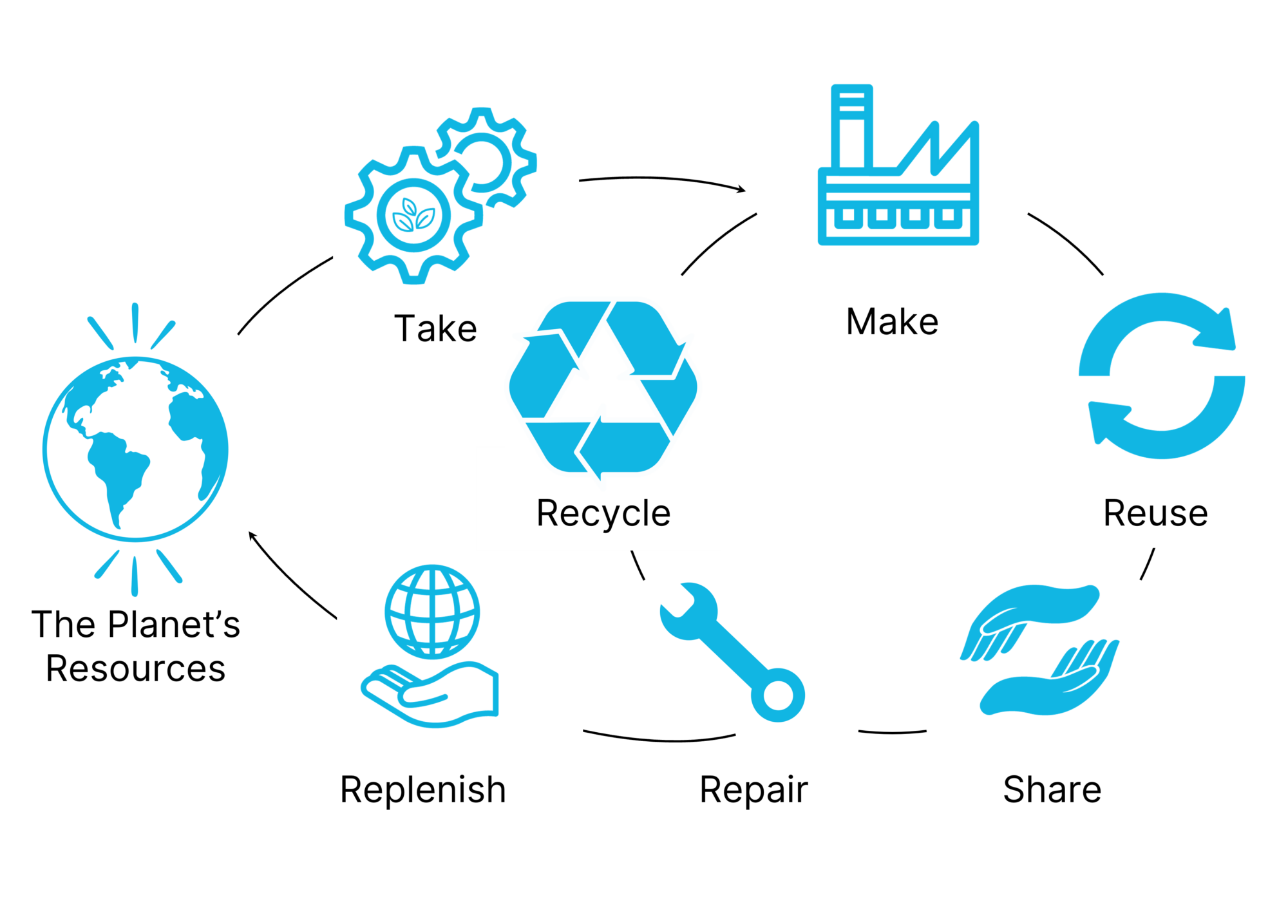Our month-long campaign kicks-off by introducing the concept of a circular economy. This week, we explain what a circular economy is, clarify common misconceptions, and show what you can do to support this new model of production and consumption.
What is the Circular Economy?
Circular economy is a new way of looking at how we use—and ultimately reuse—materials and resources. Our economy is resource-based, meaning it depends on the ability to preserve finite resources in order to succeed. Historically, products have been produced and consumed through a linear process (make, take, waste). Products are designed and used for convenience with a limited life and diminishing value over time. Environmental, economic, and social costs aren’t considered in the linear model.

Circularity incorporates better design that consumes fewer raw materials during production, maximizes value during use, and improves products and services that significantly reduce or eliminate waste. A circular economy ultimately moves beyond the linear approach to create a more sustainable, closed-loop system where resources are kept in circulation for as long as possible.

Beyond the 3Rs
The 3Rs (reduce, reuse, recycle) are important concepts, and a circular economy goes further. It prioritizes environmental protection from the start. In a circular economy, products are designed to optimize their usefulness and lifecycle, reuse is promoted, collection is improved, and investments are made in infrastructure to ultimately develop markets for recycled material which are then used to create optimized products again. An economy with a circular approach maximizes resources for years to come.
How is This Different Than Recycling?
The circular economy goes far beyond finding a recycling solution at end-of-life. Watch our video Beyond Recycling to learn how.
How Can Canadians Advance the Circular Economy?
There are many ways you can support Canada’s transition to a circular economy. Try small daily changes like reusable containers or forgoing straws. Then move to larger decisions like purchasing a refurbished computer. Businesses, governments, and individuals can use procurement and purchasing power to influence greater performance and deliver environmental and social value.
Share. A circular economy supports access over ownership. Through this shift, manufacturers are incented to make longer lasting and more efficient products that are smartly designed with durability, repairability, and reuse in mind. Support the sharing economy by borrowing, renting, and sharing products.
Repair. Purchase items that can be dismantled for repair. Purchase repaired and refurbished electronics. Spend time finding repair manuals and learning how to do-it-yourself (DIY). Support local repair shops. Visit repair cafés in your area, or host your own!
Reuse. Find other purposes for items instead of throwing them in the garbage. Support reuse by participating in container reuse programs, choosing reusables over single-use, swapping, reselling, or donating.
Recycle. Support companies that offer to take back products or packaging after use. Purchase products and packaging containing recycled materials.
Advocate. Talk to your local government representative about concerns and solutions, participate in local advocacy groups, and connect with your community to inspire change.
Resource Efficiency. Adopt sustainable practices such as waste reduction, energy efficiency, and water conservation.
Product Design. Design products for durability, repairability, and upgradability to prolong their lifespan and reduce waste.
Facilitate Reuse and Repair. Offer to refurbish or remanufacture products and establish take-back programs for customers.
Renewables. Transition to renewable energy sources and use renewable materials in product manufacturing to minimize reliance on finite resources.
Business models. Consider business models like renting products (e.g., car rental) or platforms for sharing them (e.g., car sharing) which can reduce costs, create new revenue streams, and reduce environmental impact.
Close the loop. Create closed-loop systems by recycling and reusing materials within the production process to minimize waste and resource consumption.
Ethics. Ensure the use of ethically sourced materials and promote fair trade practices throughout the supply chain.
Research and Development. Innovate and develop scalable methods or technologies that support a circular economy.
Educate. Raise awareness among consumers about the circular economy, sustainable practices, and the importance of responsible consumption.
Collaborate. Engage with government entities, NGOs, and other businesses to advocate for policy changes, share best practices, and drive collective action for a circular economy.
Implement. Enact regulations and policies that incentivize circular economy practices.
Support innovation. Allocate funds towards research, development, and execution of innovations that promote circularity.
Drive regional connectivity. Create regional or national hubs to foster collaboration between businesses, academia, and government agencies, driving circular economy initiatives and sharing knowledge.
Finance. Offer grants, loans, or subsidies to businesses that adopt circular economy practices or invest in circular business models, encouraging the transition towards circularity. Support circular startups and businesses.
Research and Development. Innovate sustainable technologies, methods, and systems that can be adopted and scaled by businesses.
Extended producer responsibility (EPR). Implement EPR regulations that hold manufacturers accountable for the entire lifecycle of their products, including implementing take-back programs and ensuring proper disposal or recycling of products at the end of their life.
Educate. Support or develop educational campaigns that inform citizens about the circular economy, sustainable consumption, and the importance of waste reduction.
Public procurement. Integrate circular economy criteria into public procurement processes, favoring products and services that meet circularity principles and sustainable criteria.
Infrastructure. Invest in efficient waste management systems, including recycling facilities, composting plants, and waste-to-energy facilities, to support circularity and reduce waste sent to landfills.
Collaborate. Engage in international collaborations and agreements to promote the circular economy globally, share best practices, and work towards a circular economy on a larger scale.
Implement. Integrate sustainable practices into school operations, such as reducing waste, conserving energy, and promoting water efficiency.
Teach. Include circular economy principles in the curriculum to educate students about resource conservation, recycling, and sustainable consumption (see our resources for schools).
Engage. Provide opportunities for students to engage in projects that promote circularity, such as upcycling materials or designing sustainable solutions.
Reduce waste. Implement waste reduction programs, establish recycling stations, and educate students on the importance of waste segregation and responsible disposal.
Repair, Share, Reuse. Encourage students to repair items instead of discarding them and promote reuse by organizing swap events or sharing initiatives within the school community.
Materials and Infrastructure. Use sustainable and recycled materials in school supplies, furniture, and infrastructure.
Food. Source food locally and prioritize sustainable options to reduce the carbon footprint associated with food production and transportation.
Support entrepreneurship. Encourage students to develop innovative circular business ideas and provide support for their implementation through mentorship programs or incubators.
Collaborate. Partner with local businesses, organizations, and government agencies to create opportunities for students to engage in circular economy initiatives and learn from real-world examples.
Advocacy. Raise awareness about the circular economy among students, parents, and the broader community through campaigns, workshops, and events.
Related Content
Week 1 Resources

